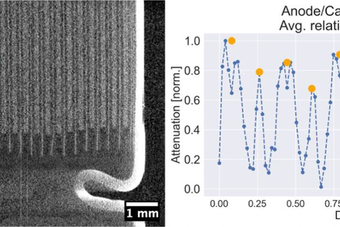Seven EIGER2 CdTe Detectors for the Extremely Brilliant Source
A 2-minute read

Image 1: Powder data collected with an EIGER2 X CdTe system at the high-pressure beamline ID27, the sample containing large single crystallite species causing strong reflexes.
“The combination of the Extremely Brilliant Source and the EIGER2 X CdTe detectors’ high dynamic range and high sensitivity will allow us to detect weak features in diffraction data, especially diffuse scattering and superstructure or impurity reflections”, says Carlotta Giacobbe, beamline scientist at the ID11 beamline of the ESRF. “We are excited about the high frame rate of the EIGER2 X CdTe. Ultrafast three-dimensional mapping and ultra-fine slicing will now be accessible to monitoring systems as they evolve during in situ experiments”.
The recent commissioning of an EIGER2 X CdTe 4M detector for the ID11 beamline is the first part of a continuing success story that will include the delivery of eight DECTRIS EIGER2 detectors in total, all of them ordered by the ESRF to exploit the power of the new Extremely Brilliant Source (EBS). Seven of these detectors will be large CdTe detectors with high sensitivity over the wide energy range that is available at many EBS beamlines.
The EIGER2 CdTe journey began in 2018, with initial tests of the detector systems at the ESRF. Beamline scientists were convinced by the features of the newly-developed detector family and its specifically designed readout chip, with frame rates up to 2 kHz and continuous (dead-time-free) readout; an enhanced photon count rate per area; and two thresholds per pixel, allowing users to suppress spurious fluorescence signals and higher harmonics; all packed into tiny 75 x 75µm2 pixels.From the variety of active-area geometries (500 K to 16 M) that are offered in this detector family, beamline scientists selected the optimal detector for their particular applications: coherent scattering, diffraction and imaging studies, biomedical imaging, high-resolution powder diffraction, macromolecular crystallography, highpressure experiments, and small- and wideangle X-ray scattering. As the detectors start to arrive at the ESRF–EBS, beamline scientists, users, and DECTRIS are excited about the new experimental possibilities and the first data sets that have been produced.
As an innovator in synchrotron science, the ESRF is known for taking the leap into new technologies. As early as 2014, the ESRF ID15 and ID31 beamlines started using PILATUS3 CdTe detectors; this dramatically enhanced beamline capabilities for fast and scanning measurements and has transformed in situ PXRD, operando XRD-CT, and PDF techniques. Now, with the upgraded source and the advanced features of EIGER2 CdTe detectors,we expect another order-of-magnitude improvement.

Image 2: Happy faces in special times, during the commissioning of the new EIGER2 X CdTe 4M detector for ESRF beamline ID11.




